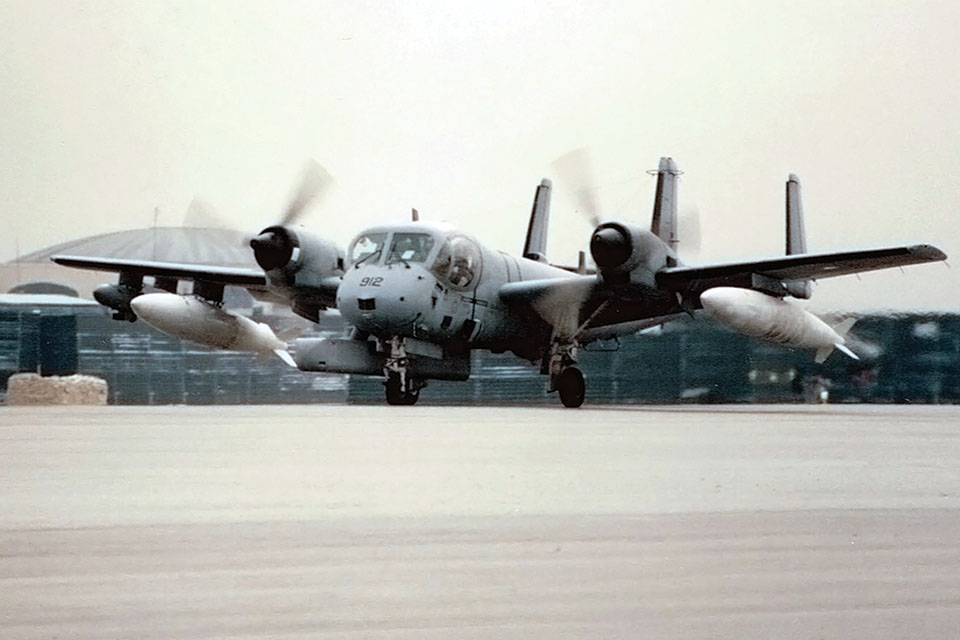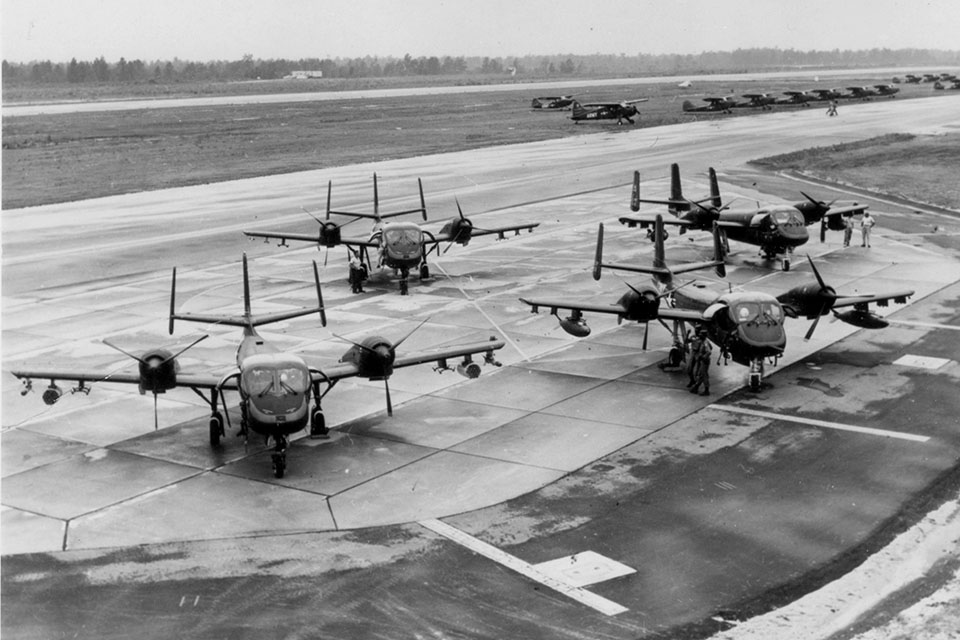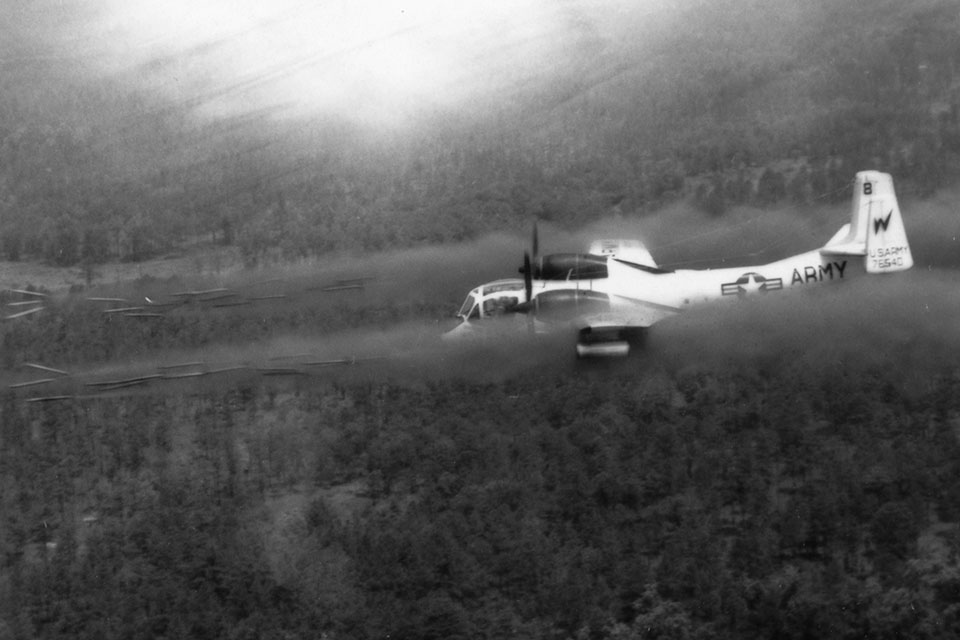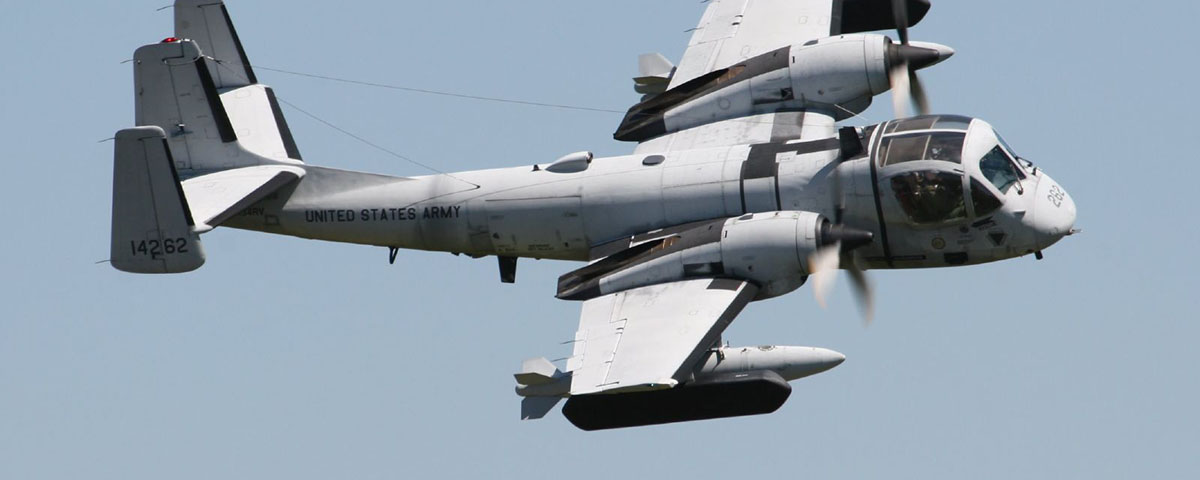Grumman’s OV-1 Mohawk battlefield recon plane is remembered as an unsung hero by its crewmen and the troops they saved.
Specialist Steve Littleton leaned back from his hooded viewer as Captain Attila Barandi banked their Grumman Mohawk left above the dark-shrouded landscape of Iraq, heading toward Qaisumah Domestic Airport in Saudi Arabia. It was February 28, 1991, during the Gulf War’s closing days. Saddam Hussein’s beaten army had torched the Kuwaiti oil wells, and a thick cloud of oily smoke blanketed the area below them—hardly ideal flying conditions.
“I’d had a bad feeling about flying in this stuff that night,” Barandi recalled, “but we’d been getting weather updates all along that the weather was ‘marginal,’ so we figured we could pull this mission off. When we got back into Saudi Arabia after midnight, though, it was pitch black outside and you couldn’t see a single light from the city I knew was below us—it was because of the oil fires. I called in and they told me again it was marginal. It sure didn’t seem marginal to me, so I asked if anyone had actually gone outside and taken a look. The reply was ‘wait one.’ A minute later they came back on and said the base was totally shut down, that you couldn’t see 50 feet!”
The Mohawk Barandi was flying, an RV-1D, had been modified some 20 years earlier for electronic intelligence gathering. Its mission in the Gulf was collecting intelligence regarding Iraqi radar, particularly important as U.S. forces closed in on what was left of the Iraqi Republican Guard.
Barandi pulled out his IFR information and tried to take it all in, reading by the light from the instrument panel while keeping the little twin-turboprop plane straight and level. “There wasn’t an ILS approach at the field, so if I was going to get down, it was going to be GCA [ground-controlled approach],” he noted. “The tower said that the field was below minimums mostly, but that it was breaking up a little bit. We said we’d give it a try. I knew there were a lot of antennas to the right of the runway at that end of the field, so I knew not to bust MDA [minimum descent altitude] because it would be real easy to hit one of those and maybe take a wing off. I descended to decision height, and it was dark as could be. About that time another Mohawk checked in, with even less fuel reserve than we had.” Barandi broke out of the clouds and saw that the runway wasn’t below him, so he executed a missed approach. Ahead was the other Mohawk, trying to land via GCA. Barandi pulled up out of the traffic area, keeping one eye on the gas gauge.
The other Mohawk was vectored into the area to the side of the runway. “That guy was so desperate to get in,” Barandi said, “he kept on coming and then reported he’d hit a windsock with his right wing, and had to use full left stick just to keep the wings level.” The other pilot also executed a missed approach, but soon tried again.
Barandi advised the tower that he had nine minutes’ fuel remaining and requested a second attempt. “I was halfway down the glide slope when the tower informed me the other aircraft had crashed on the runway,” he recalled. “They said I could land on the far end if I wanted to try. I knew if I tried to do something like that, off the glide slope, there was a good likelihood there was going to be a second crash on the strip. I could see red flashing lights through the clouds at that point and knew we weren’t landing tonight.”

Barandi pulled up and considered his options. “I called the tower and told them I was now down to five minutes’ fuel and requested a vector to get me away from the field to where there were no friendly troops, and said we would be ejecting.” Ordered to jettison the overhead hatch to clear the way for their exit, Littleton pulled the handle, but nothing happened. “I reached over and tried and there was still nothing,” said Barandi. “We were going to have to go through the canopy; there wasn’t any choice, so I ordered him to eject.
“Instead of looking away like I should have, I was looking right at him when the rocket went off.” Littleton disappeared into the night as Barandi blindly groped for his ejection trigger. “Boom! I was out of there, then the seat separated, and I was hanging in the harness. It was so damn dark, I couldn’t see the ground coming up, so I hit the ground pretty hard and got dragged by the chute a ways, which resulted in losing my flashlight.”
Barandi shed his parachute and eventually established radio contact. But he couldn’t tell anyone where he was aside from his last position report prior to ejecting, since he couldn’t read his compass in the gloom. An orbiting airborne warning and control plane (AWACS) moved closer to the ejection site, along with a pair of Air Force A-10s. Barandi recounted: “The A-10s were able to break through the smoke and fixed our positions (Littleton and I were separated) and relayed it to AWACS, who relayed it to our unit. My unit came via ground vehicles and found us. Steve was OK, with only minor facial injuries.” Barandi, with facial burns and a back injury, spent the next month in a field hospital before returning to duty. His ejection was the 95th of 96 ejections from Mohawks since the aircraft first entered service in 1962, and the last in a combat zone.
During Barandi’s ill-fated mission, his friend Captain Max Corneau had been listening in while his technical observer, in the right seat, watched the information on the CRT feed from the side-looking airborne radar (SLAR) pod below their OV-1D Mohawk’s cockpit. Corneau recalled they were flying in some of the strangest instrument conditions he had ever encountered. The oily smoke seemed thick enough to stand on, but it only extended about 10 feet above the ground. Up above, the skies were clear.
The next night, when Corneau was running the same SLAR route, explosions shattered the night. “I’ll never forget the smell after that strike,” he recalled. “It was a mixture of gunpowder, death and heavy perfume.” He had witnessed the first strike on what would be known as the “Highway of Death,” when coalition aircraft repeatedly hit retreating Iraqi forces, leaving hundreds of vehicles burned out and countless Iraqis dead.
Corneau was assigned to the 15th Military Intelligence Battalion, which had been based at Fort Hood, Texas, before it headed to Saudi Arabia in late 1990. Barandi and the 2nd MI Battalion had been flying Mohawks out of Stuttgart, West Germany, patrolling the east-west German border prior to being sent to the Middle East.
“Most of our work in Desert Storm involved the SLAR, which allowed us to do offset radar mapping and provided moving target indications [MTIs] of objects on the ground so we could call in airstrikes in bad weather,” Corneau explained. “The Mohawk could also be configured as a photo surveillance platform with three cameras, one looking forward, one panoramic camera focused directly below and a third camera with a variable-focus lens that could be slewed oblique left and right as well as straight down. Additionally, the aircraft could be fitted with look-down infrared surveillance equipment. That equipment had been very useful in Vietnam in ferreting out the Ho Chi Minh Trail and other enemy positions under the triplecanopy jungle.”
The OV-1 Mohawk had been developed in the tradition of what was known as “corps reconnaissance” in World War I, employing recon airplanes that could hold their own in air combat if necessary. Back in 1954, the Army had concluded it needed a battlefield reconnaissance plane with more capability than the Cessna L-19 Bird Dog. Initially the Marine Corps was also interested, which brought in the Navy on the Army’s side against Air Force opposition to the Army developing such an aircraft.
The type specification called for a lightweight two-seat airplane powered by twin turboprops, capable of short takeoff and landing from small, unprepared strips or Navy escort carriers. Grumman’s Model 134 won the design competition. With the retirement of escort carriers, the Navy withdrew from the process, and the Marines decided they didn’t need a plane with the capability the Army wanted.

The first prototype, designated the YAO-1AF, flew in 1959. Following the Army tradition of naming aircraft after Indian tribes, the Model 134 was christened Montauk, which was later changed to Mohawk. It reminded observers of a dragonfly, with a bug-like appearance thanks to its bulged cockpit windows, wide forward fuselage tapering to a triple rudder and large engine nacelles atop a wide-chord, short-span wing. Equipped with hydraulic flaps, leading-edge slats and hydraulic speed brakes, the Mohawk had STOL capability and was fully aerobatic, rated at plus 5G and minus 1.5G.
The OV-1 Mohawk began operations with the U.S. Seventh Army in West Germany in 1961, in time for use during the Berlin Crisis. This version specialized in photoreconnaissance, carrying a KA-60 high-resolution camera with night capability. In 1962 54 modified OV-1s—with six underwing pylons capable of carrying fuel tanks, 500-pound bombs, 2.75-inch rockets or Zuni missile packs—became OV-1As. Six of those aircraft, designated JOV-1As, were sent to South Vietnam for combat evaluation with the 23rd Special Aviation Group.
The JOV-1As were responsible for a major blowup between the Army and the Air Force in 1965 because ground commanders called on the Mohawks for close air support, traditionally the Air Force’s purview. The resulting agreement specified that Army fixed-wing aircraft would not carry offensive armament. Nevertheless, Mohawks carried underwing armament throughout their time in Southeast Asia, with the Army keeping the missions under wraps. That secretive policy extended to official Army denials after Major Ken Lee shot down a North Vietnamese MiG-17 that had attacked him and his wingman over the A Shau Valley in February 1968 (the incident was not officially recognized until 2007).

The OV-1B introduced SLAR in a canoe-like pod below the fuselage, with wider-span wings for added lift. This radar imaging capability proved to be a significant advance in peacetime as well as in war. The SLAR could look through foliage and map terrain, presenting the observer with a film image only minutes after an area had been scanned. The image was split in two parts, one detailing fixed terrain features, the other showing moving targets. Since the Mohawk was virtually silent when approaching a position, it could get within observation distance without alerting anyone to its presence. In Southeast Asia, Mohawks were able to surprise enemy forces preparing ambushes for American and South Vietnamese river patrols. Using SLAR on the border between East and West Germany and the Demilitarized Zone in Korea, Mohawk crews provided operational intelligence without violating international airspace.
Barandi and Corneau met in West Germany in 1987. After Operation Desert Storm, both men returned to Fort Hood, and in mid-1994 they were assigned to the 3rd MI Battalion in the Republic of Korea. Barandi recalled the challenges they faced:
We flew RV-1Ds, with three to four missions every night. Flying along the DMZ was hard. There was a flight corridor five miles south of the line where you could fly at any altitude. We’d take off from Camp Humphreys, go out over the Yellow Sea, turn back and fly east across the country to the Sea of Japan, turn around and fly back to midway across the country, where you turned south to return to base. These were mostly flown at night except for some missions in the afternoon. You got a very strange sensation flying the border. To the south, it was all lit up; to the north it was completely dark, effectively marking the border. You wanted to be very careful about staying in that corridor because if you strayed out of it to the north, you knew they were tracking you with radar and could potentially fire a missile at you.
The North Koreans weren’t the only problem the Mohawk crews faced. Barandi explained: “There was the restricted area known as Papa-73, a circle five kilometers in radius from the South Korean presidential palace outside Seoul, and we were very definitely not to overfly that area. I did once, when we had thunderstorms in all quadrants, and I was warned on the radio that they were tracking me with missiles. When I got back to Camp Humphreys, they had me in interrogation in this little room at base operations for several hours before the Korean security guys were convinced it was just an accident due to the bad weather.”
Max Corneau had good reason to remember the mission he flew on New Year’s Day 1995: “My primary aircraft for this SLAR mission was a full year older than me. Our profile for the mission took us up to the very edge of the DMZ, then out to the Sea of Japan and back again. When I received the aircraft from maintenance, the maintenance record showed a strange history of the autopilot not disengaging. In fact, this happened on the previous flight and was written up by the maintenance guys as ‘tested on ground—could not duplicate.’ I questioned the write-up and was given the standard answer: ‘You can always just turn off the mission inverters and the autopilot will come off line.’ I took the airplane because the backup bird was not in any better condition and the radar on this plane was known to be a cherry system.”
Corneau’s flight was uneventful until he arrived at the turnaround point over the Sea of Japan:
When I got to this point in a mission, one of my habits was to disengage the autopilot as we went feet wet, turn 90 degrees to the right, then bank sharply to the left while powering up to maintain altitude through a 60- degree banked turn of 270 degrees. This procedure would get my blood flowing in the wee hours of the morning and it let me feel the airplane’s condition, whether we had picked up any stray ice, had an uneven fuel burn, or something. On this mission, this was when I learned that my autopilot would not allow itself to be disengaged.
Our home base at Camp Humphreys was shrouded in low clouds and fog and was at low IFR conditions. I double-checked the weather at home and they confirmed that it was bad everywhere in Korea that night. I was going to have to find a way to disengage the autopilot in the next 45 minutes or I would be forced to eject because I needed flight instruments to fly and navigation equipment to get to my destination in the bad weather. I literally tried every circuit breaker in the book as well as every button available to disengage the system, and nothing worked. There was one more piece of equipment in the system I hadn’t checked: the autopilot control knob on the lower console. I unscrewed the control head from the console, inspected it and found a large J-cable fitting. I unscrewed the fitting most of the way, handed it to my right-seater and told him to loosen it to the end and then pull the cable from the control head. We rehearsed it and then we did it. Maybe because I told him that there might be sparks and the airplane might lurch considerably, the procedure was completely benign. With the autopilot disengaged, I was able to preserve the inertial navigation system, gyros and navigation instruments. We flew three hours that night, shot the ILS 36 and logged three hours of night instrument time. This was one for the record books as I have never in all my years heard of an autopilot not disengaging.
At Oshkosh in 2010, Corneau met Mohawk aerobatics pilot Joe Masses, who told him about a time when his autopilot failed to disengage on a trip to Wisconsin. Corneau related his own experience in Korea, and recalled: “He said his mechanic never told him to do that. I told him it wasn’t in the books, but it might have saved my life once.”
Contracts for the OV-1 dried up in 1964, but the plane’s success in Vietnam led to additional orders in 1966. The last version was the OV-1D, with more-powerful T53-701 engines, improved avionics and interchangeable mission pallets, allowing ground crews to switch the aircraft from infrared to SLAR configuration in less than an hour.
Thirty-seven new-build OV-1Ds were produced, the last of them delivered in December 1970. The Motorola AN/APS-94F SLAR had a range of 60 miles, and the radar picture could be data-linked to a ground station. In the 1980s an improved SLAR called E-Scan was installed. Many OV-1B airframes were returned to the factory and brought up to OV-1D specs after the Vietnam War. Fifty of the Mohawks were further modified during the 1970s to RV-1Ds, with advanced electronic intelligence (ELINT) equipment. These could be distinguished from the OV-1Ds by their lack of an SLAR canoe and the two large ELINT pods they carried on underwing pylons.
After more than 30 years’ service, the OV-1 was retired from Europe in 1992 and Korea in 1996. Operation Desert Storm was the swan song for the Mohawk, the last purpose-designed manned battlefield recon aircraft operated by the U.S. Today UAVs handle battlefield recon.
Twenty-three Mohawks were sold to the Argentine army, 10 of which were still in use as of 2009. Beginning in the late 1970s, the U.S. Border Patrol used 10 OV-1s along the Mexican border to chase drug smugglers. No one has ever said exactly how successful these Mohawks were, but their infrared capability made it possible to identify smugglers even on moonless nights.
In 2011 Alliant Techsystems and Mohawk Technologies proposed an armed version of the OV-1D for use as a counterinsurgency tool. A demonstrator was equipped with a Star Safire FLIR turret and a ventral 30mm M230 chain gun from an Apache gunship.
The Mohawk was mostly unheralded and unsung by anyone but its crews and the ground troops it supported, but it was definitely loved. One Army Ranger whose life was saved several times by OV-1s in Vietnam said, “That airplane was underestimated by everyone who never worked with one.”
Thomas McKelvey Cleaver last wrote for Aviation History about the Vought F-8 Crusader. Further reading: OV-1 Mohawk in Action, by Terry Love; and OV-1 Mohawk, by Ken Neubeck.
Originally published in the September 2012 issue of Aviation History. To subscribe, click here.
Inspired to make your own model Mohawk?





